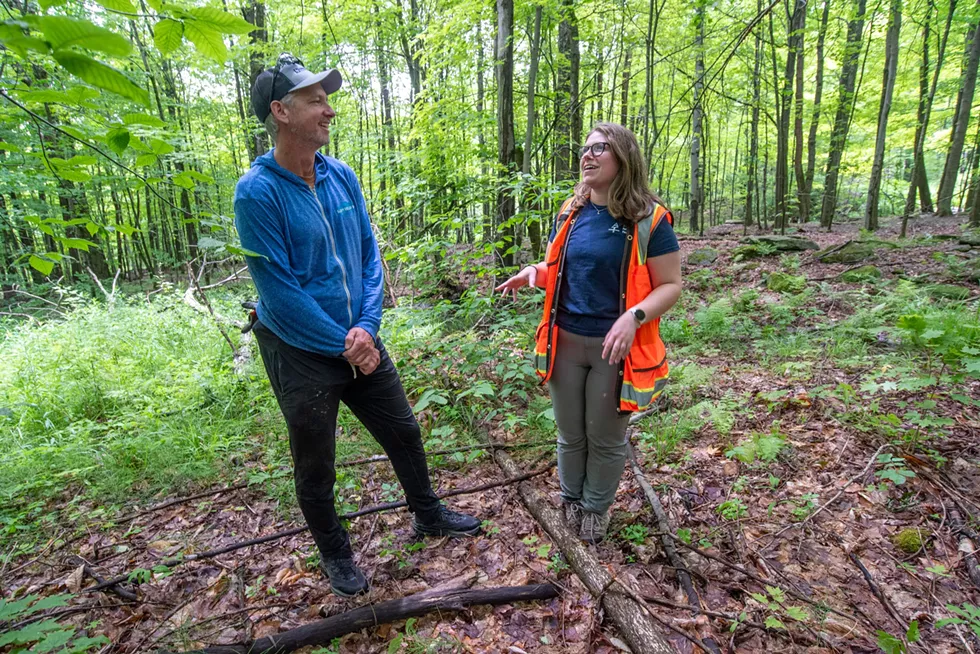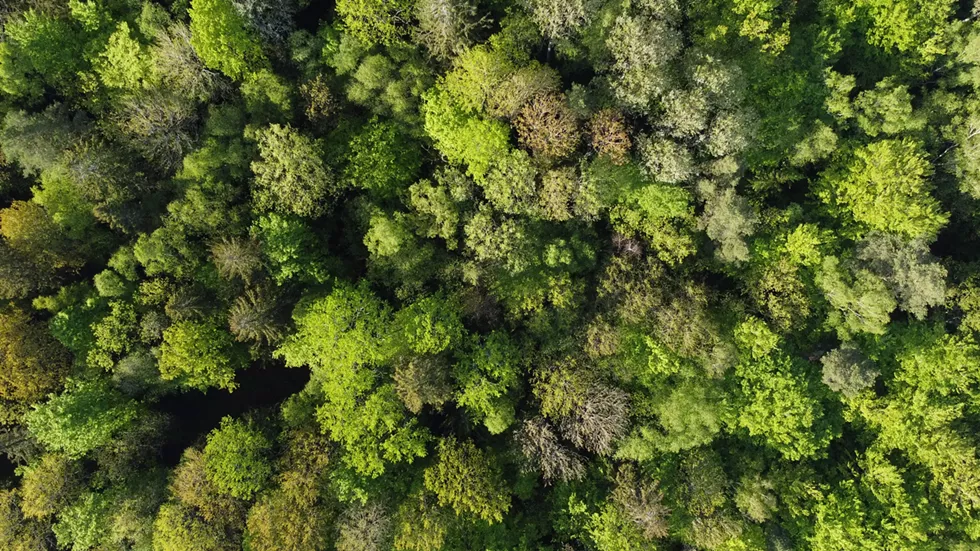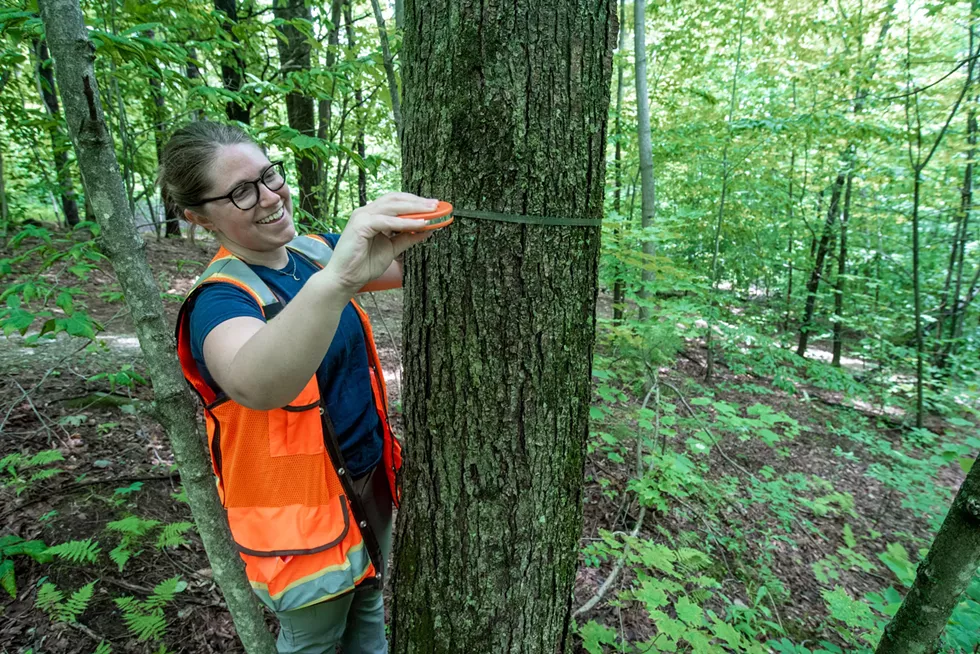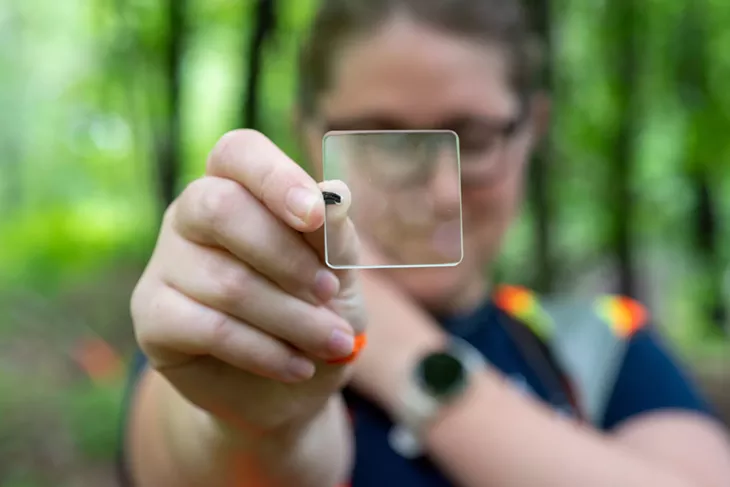Vermont landowners have a unique opportunity to improve the health of their forest and earn money doing it. For those with at least 30 acres of forest, the Family Forest Carbon Program helps turn privately owned woods into a source of income while creating a plan that will conserve the land for future generations.
Run by the American Forest Foundation and developed in partnership with the Nature Conservancy, the program expanded into Vermont about three years ago. Eli Enman and his family were among the first in the state to sign up. Eli; his sister, Molly; and their parents co-own Sleepy Hollow Inn, Ski and Bike Center in Huntington, which consists of a Nordic ski area, bike trails and an inn.
Growing up in St. George, Eli was a dedicated skier. He participated in the World Cup and achieved several victories at the Craftsbury Marathon Ski Festival. Molly is the former Nordic skiing head coach and current cross-country and track coach at Saint Michael’s College in Colchester.
“It was always our family dream to purchase a ski area together,” Eli said. Since they bought Sleepy Hollow in 1999, the family can frequently be found on the slopes.
About 700 of Sleepy Hollow’s 800-plus acres are forest and eligible for the Family Forest Carbon Program.
“We care deeply about climate change, so we wanted to do our part,” Eli said. “The money aspect didn’t hurt, either.”
The process was simple. Because the Enmans already work with a forester, they just had to submit basic ownership documents, forest details and future plans. For landowners who don’t already work with a forester, the program connects them with a staff forester or a consulting forester affiliated with the program. These foresters assess the land and landowner goals, determine eligibility, and plan the project at no charge. Within a month of enrolling, most members receive their first down payment.
“Lots of people don’t have the technical knowledge to sustainably take care of their land or have the money to do it,” said Lynn Riley, lead scientist at the American Forest Foundation. “We solve that by connecting people with foresters, coming up with plans to manage their forests and paying them money to do it.”
Riley believes all those parcels of managed forest will add up and contribute to a larger goal: a positive, lasting impact on the planet.
Getting Carbon Credit
In addition to maintaining a healthier forest on their land, the Enman family will receive $140,000 from the program over a 20-year contract period. The money is guaranteed to be paid out annually by the American Forest Foundation throughout the contract period. These payouts are funded by the sale of carbon credits, to which the Enmans’ land contributes. A healthier forest is able to store carbon more efficiently.
“My favorite way to describe how forests store carbon is to imagine that you’re in bed and you’re putting blankets on yourself,” Riley said. “If you’re Earth and the atmosphere is a blanket, that’s comfortable. Most people like to have a blanket on them, and for the life that exists on Earth, we want a level of carbon dioxide and gases in the atmosphere. But if there were too many blankets, that would be uncomfortable. With the emission of greenhouse gases, we’re basically adding tons more blankets to the atmosphere. When we manage forests sustainably, the result is like removing blankets from the bed.”
Each cycle of forestry leads to the storage of more carbon. However, many forests are operating below maximum efficiency, Riley said. Through the Family Forest Carbon Program, private landowners can enhance carbon storage in the forest and removal from the atmosphere by implementing improved forest management practices. These practices include extending the time between harvests, deterring unsustainable harvesting, encouraging forest regeneration, reducing wildfire risk and treating invasive species, which are all crucial to a healthy forest and climate.
The Enmans are one of many family forest owners in Vermont enrolled in the Vermont State Current Use Program (UVA). During the enrollment process, the Family Forest Carbon Program staff ensure that their program is compatible with landowners enrolled in current use. Since expanding into Vermont, the Family Forest Carbon Program has enrolled more than 70 landowners and families in the state, representing about 13,000 acres of Vermont forestland.
The Family Forest Carbon Program measures the benefit that enrolled landowners make to the climate through carbon storage and turns that into carbon credits, which are sold to fund the program. Foresters measure selected forests, recording information about the number, size and species of trees. The program compares the information they collect to data maintained by the U.S. Forest Service on similar but unenrolled forests. Every few years, both sets of plots are measured and compared to each other. As a difference appears in the amount of carbon that is stored in program-enrolled forests versus unenrolled forests, the program can quantify the additional carbon stored. The Family Forest Carbon Program then registers that difference as carbon credits that are sold to corporations and used to fund the program, paying landowners such as the Enmans.
“Trees help remove carbon dioxide from the air, which is a huge greenhouse gas and hurts our climate,” said Jill Levine, a forester for the American Forest Foundation. “And trees are a carbon sink. The more they store, the less is in the atmosphere, and that’s our goal.”
These days, many corporations are seeking to reduce their carbon footprint, which is the carbon a company directly or indirectly releases into the atmosphere. Carbon credits are one way to address this. The American Forest Foundation assesses every single company it works with to ensure that it is contributing in good faith and is invested in caring for the environment. Once collected, that credit money is used to pay the participating landowners.
The Enman family used the money they’ve received from the program to help purchase an electric groomer to manage their ski trails at Sleepy Hollow.
“An electric groomer was more expensive than a diesel groomer, so we were really weighing what to do,” Eli said. “But this program helped push us over the edge, so we were able to afford a groomer that was better for the environment, too.”
Forestry for Good
Forester Levine is responsible for site visits when a landowner enrolls in the Family Forest Carbon Program. Located in Burlington as the program’s first and only Vermont-based forester, she travels to all parts of the state to collect data from landowners.
At the University of Vermont, Levine had a double major in biology and forestry. When she graduated, she worked part time doing seasonal fieldwork and as an EMT before joining the American Forest Foundation in 2023.
She has a keen eye when it comes to trees. After just a few minutes at Sleepy Hollow, Levine could tell how long ago logging roads had been built and could estimate whether the forest was well stocked. She still leans on records and measurable data for this information, but she’s learned to notice patterns.
“Sleepy Hollow is a younger forest in Vermont, but that’s great. We need young and old forests in Vermont for so many reasons,” Levine said. “For example, certain birds enjoy young trees, and some like old trees, and some like standing dead trees. So it’s better for the diversity of all kinds of species.”
On a site visit, Levine ventures far into the forest and chooses a plot from which to collect data. First, she holds a prism up to her eye to measure which trees fit into the plot. From there, she goes up to each eligible tree, takes out her diameter tape and wraps it around the tree to measure its size. She also writes down all the tree species she sees and takes note of any possible disease.
For land to be eligible, in addition to the 30 required acres, the forest must be primarily composed of northern hardwood species, such as maple, beech or birch trees.
Every five years, Levine returns to the same plots on the site and takes the same measurements. “Over time, we are looking for consistency in data,” she explained.
Not every new member of the program requires a site visit. If a landowner has already worked with a forester who has done recent site-mapping visits of their land in addition to using satellite geospatial data and other land records, the Family Forest Carbon Program will likely be able to enroll the land without sending a forester out in person.
After the site visit is complete and an enrollment contract has been signed, Levine sits down to write the management plan that works best for the landowner’s needs within the criteria of the program. For example, if the landowner is seeing emerald ash borer, an invasive species, on their land, she may ask them to do a harvest in a certain area. The plan also contains other advice on how to manage common forest health threats.
Levine emphasizes that she works with the landowners on their plan so they can manage their forest the way they want. Such plans don’t inhibit recreation, such as cross-country skiing, hunting and hiking, but she can recommend ways to host those activities that are better for the land. The plans may also allow limited harvesting on enrolled land while guiding landowners through sustainable methods.
“Forestry matters because it provides economic and social benefits, as well as ecological ones,” Levine said. “Trees clean our air and our water and provide food and timber for us. They filter pollutants out from our water and our air and stabilize our soil so we can combat erosion, stopping landslides and floods. Taking part in the Family Forest Carbon Program is just one small way someone can help with all of those things.”






